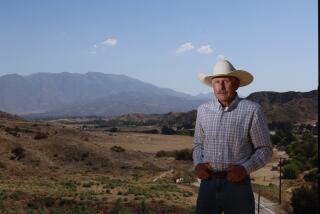Azusa Residents Help Plan Future of Last Rural Site
Ron Lohr moved to Azusa because he wanted to live among the orange trees. The longtime United Parcel Service driver was charmed by its spaciousness and neighborhood feel.
Since he arrived nearly 40 years ago, he has seen the town’s agricultural character fade away as citrus groves were cut down and shopping centers popped up. Today, the 500-acre Monrovia Nursery headquarters in Azusa is the last remaining open agricultural space in the San Gabriel Valley.
On Saturday, Lohr, other residents and city officials took the first step in deciding what should become of the swath of land, which virtually bisects the city.
At a community forum, four urban design firms pitched their ideas on how to develop the hillside property. Some of the proposals hark back to the city’s agricultural roots; others evoke new urbanism, suggesting a spiritual component to the development.
City officials and the owners of the Monrovia Nursery have opened to Azusa residents what typically is a closed process. Officials are asking residents to help decide how to develop the land and which design firm should complete the project. Lohr and other residents were invited to help decide the site’s fate.
Two years ago, voters defeated a referendum that would have allowed Lewis Homes to transform the property into a 1,600-home development. Opponents of the plan worried that new homes would bring traffic to the area and destroy wildlife and bluffs along the San Gabriel foothills.
City officials went back to the drawing board, and this time decided to turn the process inside-out. With the support of the board of directors of the Monrovia Nursery, they hired four urban design firms to develop concept plans for the site without the limitations of budget, zoning laws or the interference of a developer.
“No one has ever, in Southern California in the last 20 years, done a design competition for this big a piece of land, or has done it with a jury of the community,” said Azusa City Manager Rick Cole, who is overseeing the competition. “In this case, we are looking for a new-urbanist approach, which is not tract homes with houses that all look alike, but rather a much more finely grained, neotraditional neighborhood.”
Each firm was paid $50,000 for work on this initial stage; $150,000 was provided by the Monrovia Nursery, with the city kicking in the final $50,000. Among the contenders: two design firms from Southern California, one from Maryland and another from Oregon.
Two hundred mountainous acres of the site, in the San Gabriel foothills, were left untouched by designers. For the other 300 acres, parks and recreational areas, multiuse areas where homes and offices could coexist and a variety of types and styles of homes were incorporated into all four plans. Other ideas included botanical gardens, a meditation center, hiking and biking trails, Internet hubs, running creeks and a village evocative of an Italian hill town.
More than 200 Azusa residents attended the five-hour workshop to view the proposals and ask questions of the designers. After seeing all four plans, they completed a 20-question evaluation of the principles and elements in each proposal.
The fact that citizens are being consulted at the beginning of this massive development project, said City Councilman Dick Stanford, means that there will be fewer naysayers later in the process.
“No one was standing up and screaming, ‘That’s terrible,’ ” he said Saturday. “There’s a willingness on the part of citizens to participate in this process, to work at it.”
When results were tallied, according to Cole, virtually all of the feedback was positive. “There was some broad agreement among the community for shared elements: Unlike the previous development proposal, the streets had to interconnect with the rest of Azusa. It had to be a walkable neighborhood, with a variety of home types and styles.”
Citizens overwhelmingly rejected the idea of cookie-cutter subdivisions in favor of more traditional homes with small-town character. Sidewalks, lush landscaping and large front porches were popular with those who attended the workshop.
All four firms scored well with residents; the next step in the process is for city officials to sit down with Monrovia Nursery owners and review feedback from the questionnaires. Based on those responses, they will choose a design firm for the project within the next month; that firm will then begin a series of town hall meetings with residents to further refine a plan for the property.
More to Read
Sign up for Essential California
The most important California stories and recommendations in your inbox every morning.
You may occasionally receive promotional content from the Los Angeles Times.










